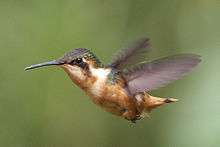Gorgeted woodstar
The gorgeted woodstar (Chaetocercus heliodor) is a species of hummingbird in the family Trochilidae. It is found in Colombia and Venezuela, and also has an isolated population in Ecuador. Its natural habitats are subtropical or tropical moist montane forest and heavily degraded former forest. This species favors forested areas highly but can be seen at flowering trees in gardens and in semi-open. The tail is frequently wagged while feeding.
| Gorgeted woodstar | |
|---|---|
 | |
| Female in NE Ecuador | |
| Scientific classification | |
| Kingdom: | Animalia |
| Phylum: | Chordata |
| Class: | Aves |
| Order: | Apodiformes |
| Family: | Trochilidae |
| Genus: | Chaetocercus |
| Species: | C. heliodor |
| Binomial name | |
| Chaetocercus heliodor Bourcier, 1840 | |
| Synonyms | |
|
Acestrura heliodor (Bourcier, 1840) | |
This tiny bird is 7 cm (2.7 in) in total length, making it one of the smallest birds native to South America alongside the short-tailed woodstar and Esmeraldas woodstar.[2] The gorgeted woodstar is dark shining green above with a short white postocular stripe and white patch on the sides of the lower back extending to the lower flanks. The male's gorget is glittering pinkish violet and has elongated, pointed sides that hang around the throat. The white pectoral collar is less evident than in other woodstars. The breast is grayish and the belly is blue-green. The tail is forked and fairly short, with a spiky, narrow appearance. The female is similar overall but lacks the gorget and brighter coloration. There is limited overlap in the wild with the little woodstar but the female of that species is superficially indistinguishable from this one.
References
- "The Birds of Ecuador" by Robert S. Ridgely & Paul Greenfield. Cornell University Press (2001), ISBN 978-0-8014-8722-4.
- BirdLife International (2012). "Chaetocercus heliodor". IUCN Red List of Threatened Species. 2012. Retrieved 26 November 2013.CS1 maint: ref=harv (link)
- Fjeldså, J.; Krabbe, N. (1990). Birds of the High Andes: A Manual to the Birds of the Temperate Zone of the Andes and Patagonia, South America. Zoological Museum, University of Copenhagen. p. 297. ISBN 9788788757163. Retrieved 13 April 2015.
External links
- Gorgeted Woodstar videos on the Internet Bird Collection
- Photo(called "Gorgetted"); Article sunbirdtours
- Gorgeted Woodstar photo gallery VIREO
